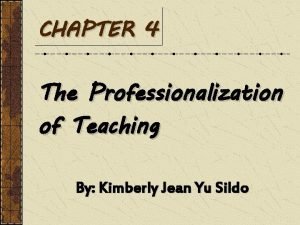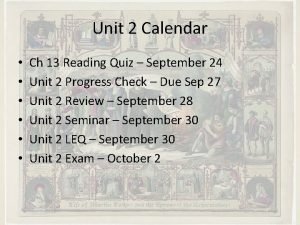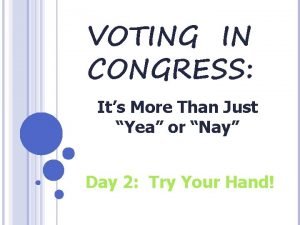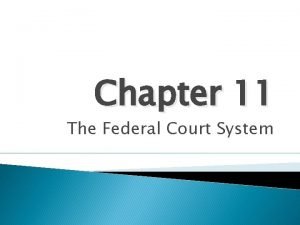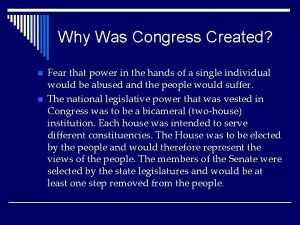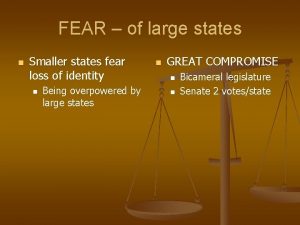Congress Why Was Congress Created Fear that power






































- Slides: 38

Congress

Why Was Congress Created? • Fear that power in the hands of a single individual would be abused and the people would suffer. • The national legislative power that was vested in Congress was to be a bicameral (two-house) institution. Copyright © 2011 Cengage Learning © Randy Duchaine/Corbis 2

The Functions of the Congress • Lawmaking • Representation • Trustee view • Instructed delegate view • Politico style (combination) • Service to constituents Copyright © 2011 Cengage Learning 3

The Functions of the Congress (cont. ) • Oversight • Reviewing actions of the Executive Branch • Hearings, investigations • Public-Education • Conflict Resolution Copyright © 2011 Cengage Learning © Richard T. Nowitz /Corbis 4

The Powers of Congress • Enumerated Powers (Article I, Section 8 of the Constitution) • Include taxing, spending, borrowing, and coining; regulation of foreign trade and trade among states; regulation of the military (state militias, an army and navy, and to declare war); power to define the court structure • Powers of the Senate • Constitutional Amendments (AP Copyright © 2011 Cengage Learning Photo/The Republican/Christopher Evans) 5

The Necessary and Proper Clause Allows Congress to make laws that are deemed to be necessary to carry out the expressed powers © Owen Franken /Corbis Copyright © 2011 Cengage Learning 6

Who Can Serve? • Minimum age 25 in House; 35 in Senate • Citizen • Must reside in state of election • Local identity less of a factor for Senators • Term limits determined by individual states • House districts roughly equal in population; established every ten years by reapportionment Copyright © 2011 Cengage Learning 7

Basic House–Senate Differences • Size and rules • Debate and filibustering • Prestige Senator Orrin Hatch of Utah (AP Photo/APTN) Copyright © 2011 Cengage Learning 8

Differences Between House and Senate HOUSE SENATE • • • • • Larger (435 members) Shorter term (2 years) Less flexible rules Narrower constituency Policy specialists Less prestige More expeditious floor debate Less reliance on staff Less media coverage More partisan Smaller (100 members) Longer term (6 years) More flexible rules Broader constituency Policy generalists More prestige Less expeditious floor debate More reliance on staff More media coverage Less partisan Copyright © 2011 Cengage Learning 9

Size and Rules • Because the House is so large, it operates under stricter rules for debate. • Rules Committee provides special rules under which specific bills can be debated, amended, and considered • Rules Committee most powerful in House Copyright © 2011 Cengage Learning 10

Debate and Filibustering • Filibuster: the Senate’s use of unlimited debate as a blocking tactic. • Members of the Senate are generally able to achieve more prestige than members of the House because of the smaller number of members. Copyright © 2011 Cengage Learning 11

Congress and the Citizenry: A Comparison • Members of Congress are older, wealthier, and better educated than general public • Relatively few women and members of minority groups in Congress • Disproportionate number of lawyers in Congress • Current congressional salary is $174, 000 Copyright © 2011 Cengage Learning 12

Nancy Pelosi First Female Speaker of the House Getty Images Copyright © 2011 Cengage Learning 13

Congressional Elections • Candidates self-selected or recruited • Congressional campaigns and elections • Biggest spenders usually win • Presidential election effects less evident in recent years • Incumbents • Significantly more likely to be reelected • Pursuit of reelection strong motivator Copyright © 2011 Cengage Learning 14

Representing the State? Click the icon to open the movie Video Supplied by Motion Gallery This story covers the election victory of the Democrat Senate candidate Al Franken nearly eight months after election day, when the Supreme Court of Minnesota determined that Franken was the winner. Air date: 6/30/2009 Copyright © 2011 Cengage Learning 15

Video Questions 1. Should a senator represent the people of his/her state, or the country as a whole? How would the founding fathers respond to this question? 2. Is the majority party’s power to stop a filibuster significant? 3. Why are senators more interested in pleasing their constituents than the president, even if they are of the same party? Copyright © 2011 Cengage Learning 16

Congressional Apportionment • House seats are apportioned among the states every ten years (following the census) • Reapportionment (federal) • Redistricting (state) Copyright © 2011 Cengage Learning 17

Congressional Apportionment (cont) • Gerrymandering: drawing of boundaries to obtain a partisan advantage • Redistricting after the 2000 Census • Will 2010 Census lead to significant redistricting? • Minority–majority districts • Encouraged by government to maximize minority interests Copyright © 2011 Cengage Learning 18

The Original Gerrymander Copyright © 2011 Cengage Learning 19

Fourth Congressional District of Illinois Copyright © 2011 Cengage Learning 20

Perks and Privileges • Pensions and health care • Permanent professional staffs • Congressional agencies • Privileges and immunities under the law • Congressional caucuses Copyright © 2011 Cengage Learning © George Tames/New York Times 21

The Committee Structure • The Power of Committees • Standing Committees (most important) • Select Committees (temporary) • Joint Committees • Conference Committees • House Rules Committees • Significant gatekeeping role • Powerful Copyright © 2011 Cengage Learning 22

The Committee Structure (cont) • The Selection of Committee Members • • Appointed by Steering Committee of own party Informal seniority system Chairperson most senior member of majority party Ranking committee member is most senior member of minority party Copyright © 2011 Cengage Learning 23

How Congress is Managed Democrats move to change Senator Lieberman’s committee assignments after he campaigns for Mc. Cain during the 2008 presidential election. Air date: 11/19/2008 Click the icon to open the movie Video Supplied by Motion Gallery Copyright © 2011 Cengage Learning 24

Video Questions 1. How are Senate committee chairmanships decided? Is there a better system? 2. Did Lieberman show disloyalty to his former party by campaigning for Mc. Cain? 3. How does the seniority system improve the functioning of the Senate? 4. Should the vice president take a more active role in the committee leadership of the Senate? Copyright © 2011 Cengage Learning 25

Formal Leadership • Majority party controls the legislative process, including the selection of Congressional leaders • Leadership in the House • • Speaker of the House Majority Leader Minority Leader Whips Copyright © 2011 Cengage Learning © Dennis Brack /Black Star/Stockphoto. com 26

Leadership in the Senate • Vice President • Majority Leader • Whips • Minority Leader • Whips Copyright © 2011 Cengage Learning 27

Congressional Decision-Making • Party membership is a major determinant of how members vote, but not the only factor • The Conservative Coalition • “Crossing over” (voting against party stance) Copyright © 2011 Cengage Learning 28

How a Bill Becomes a Law • For a bill to become law, it must pass through both houses of Congress. • All spending measures must originate in House • House of Representatives • Introduction • Committee Stage • Rules Committee • Floor Action • The procedure in the Senate is similar, but there are no special rules such as those set by the House Rules Committee; the leadership schedules action. Copyright © 2011 Cengage Learning 29

Copyright © 2011 Cengage Learning 30

How a Bill Becomes a Law (cont) • Conference committee • If there are differences between the House version of the bill and the Senate version of the bill, the bill will be sent to a conference committee. Members of each chamber selected by the leaders will attempt to reach a compromise on the bill. • House and Senate vote on bill as reported by conference committee Copyright © 2011 Cengage Learning 31

The Life of a Senator Courtesy of Senator Durbin Copyright © 2011 Cengage Learning 32

Representing the People Rep. Barbara Lee Rep. John Boehner Rep. Judy Chu Copyright © 2011 Cengage Learning 33

How Much Will the Government Spend? • Preparing the Budget • Congress Faces the Budget • Authorization • Appropriation • Budget Resolutions © UPI Photo/Roger L. Wollenberg/Landov Copyright © 2011 Cengage Learning 34

The Budget Cycle Copyright © 2011 Cengage Learning 35

Questions for Critical Thinking 1. Why did the framers create a bicameral legislature? Was part of the reason for a two-house legislature the idea that it would be more difficult to pass legislation, therefore, a check on a runaway legislature? What impact does this have today? 2. Discuss recent major examples of “crossing over” in Congress. 3. Should there be major differences between the House and Senate? Copyright © 2011 Cengage Learning 36

Questions for Critical Thinking 4. How do the increasing costs of congressional campaigns impact who can run for Congress? 5. Do different rules for each chamber, like the filibuster in the Senate, help to balance power in the two Houses? 6. Although the problems have changed since 1789, have the basic ideas of representation changed? If so, in what ways? Copyright © 2011 Cengage Learning 37

Web Links • • • The Library of Congress C-SPAN The Washington Post Roll Call The Center for Public Integrity Copyright © 2011 Cengage Learning 38
 Andreas carlsson bye bye bye
Andreas carlsson bye bye bye What have you learned about modifiers of human act?
What have you learned about modifiers of human act? Phân độ lown
Phân độ lown Block xoang nhĩ độ 2 type 1
Block xoang nhĩ độ 2 type 1 Thể thơ truyền thống
Thể thơ truyền thống Thơ thất ngôn tứ tuyệt đường luật
Thơ thất ngôn tứ tuyệt đường luật Chiến lược kinh doanh quốc tế của walmart
Chiến lược kinh doanh quốc tế của walmart Tìm vết của mặt phẳng
Tìm vết của mặt phẳng Con hãy đưa tay khi thấy người vấp ngã
Con hãy đưa tay khi thấy người vấp ngã Tôn thất thuyết là ai
Tôn thất thuyết là ai Gây tê cơ vuông thắt lưng
Gây tê cơ vuông thắt lưng Sau thất bại ở hồ điển triệt
Sau thất bại ở hồ điển triệt The real lesson 21
The real lesson 21 Don't ask why why why
Don't ask why why why Find the average power pavg created by the force f.
Find the average power pavg created by the force f. Macbeth act 3 scene 1 quotes
Macbeth act 3 scene 1 quotes Why did the great fear swept through france
Why did the great fear swept through france The lord is my light hymn 515
The lord is my light hymn 515 Why do some brains enjoy fear allegra ringo summary
Why do some brains enjoy fear allegra ringo summary Why do ldcs fear the loss of folk culture
Why do ldcs fear the loss of folk culture Why was the truman doctrine created
Why was the truman doctrine created The professionalization of teaching in the philippines
The professionalization of teaching in the philippines Why was it created
Why was it created Gudea
Gudea What does nato stand for? *
What does nato stand for? * Sur letable
Sur letable Bill a no mail on saturdays worksheet answers
Bill a no mail on saturdays worksheet answers The federal court system chapter 11 answer key
The federal court system chapter 11 answer key Implied power example
Implied power example What are two non legislative powers given to congress
What are two non legislative powers given to congress Why did johnson and congress clash over reconstruction
Why did johnson and congress clash over reconstruction Pearland instructure
Pearland instructure Solar power satellites and microwave power transmission
Solar power satellites and microwave power transmission Actual power
Actual power Flex28024a
Flex28024a The dispersive power of a grating
The dispersive power of a grating Power of a power property
Power of a power property General power rule vs power rule
General power rule vs power rule Power angle curve in power system stability
Power angle curve in power system stability





















